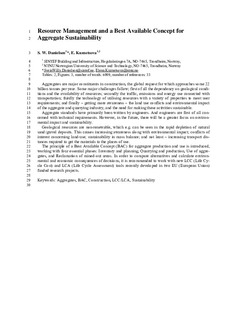| dc.description.abstract | Aggregates are major constituents in construction, the global demand for which approaches some 22 billion tonnes per year. Some major challenges follow: firstly, the dependency on geological conditions and the availability of resources; secondly, the traffic, emissions and energy use connected with transportation; thirdly, the technology of utilizing resources with a variety of properties to meet user requirements; and finally, the need for increased awareness, particularly over issues like land-use conflicts, environmental impact of the aggregate and quarrying industry, and the need to make these activities sustainable. Aggregate standards have primarily been written by engineers, and engineers are first of all concerned with technical requirements. However, in the future, there will be a greater focus on environmental impact and sustainability. Geological resources are non-renewable, which, for example, can be seen in the rapid depletion of natural sand/gravel deposits. This causes increasing awareness along with environmental impact, conflicts of interest concerning land use, sustainability in mass balance and – not least – increasing transport distances required to get the materials to the places of use. The principle of a Best Available Concept (BAC) for aggregate production and use is introduced, working with four essential phases: inventory and planning; quarrying and production; use of aggregates; and reclamation of mined-out areas. In order to compare alternatives and calculate environmental and economic consequences of decisions, it is recommended that new LCC (Life Cycle Cost) and LCA (Life Cycle Assessment) tools are worked with, which have been recently developed in two EU (European Union) funded research projects. | nb_NO |
